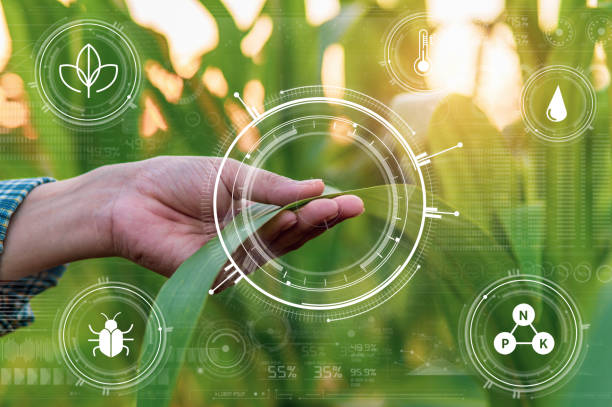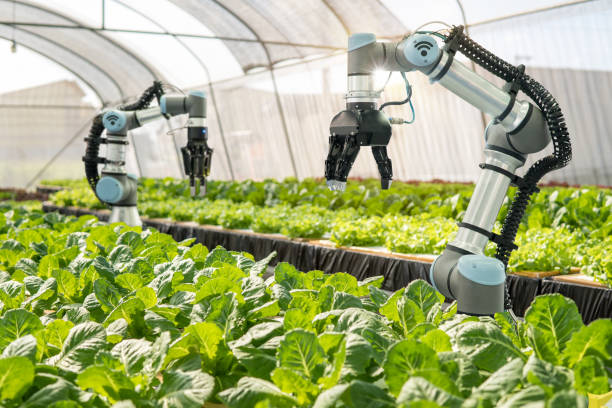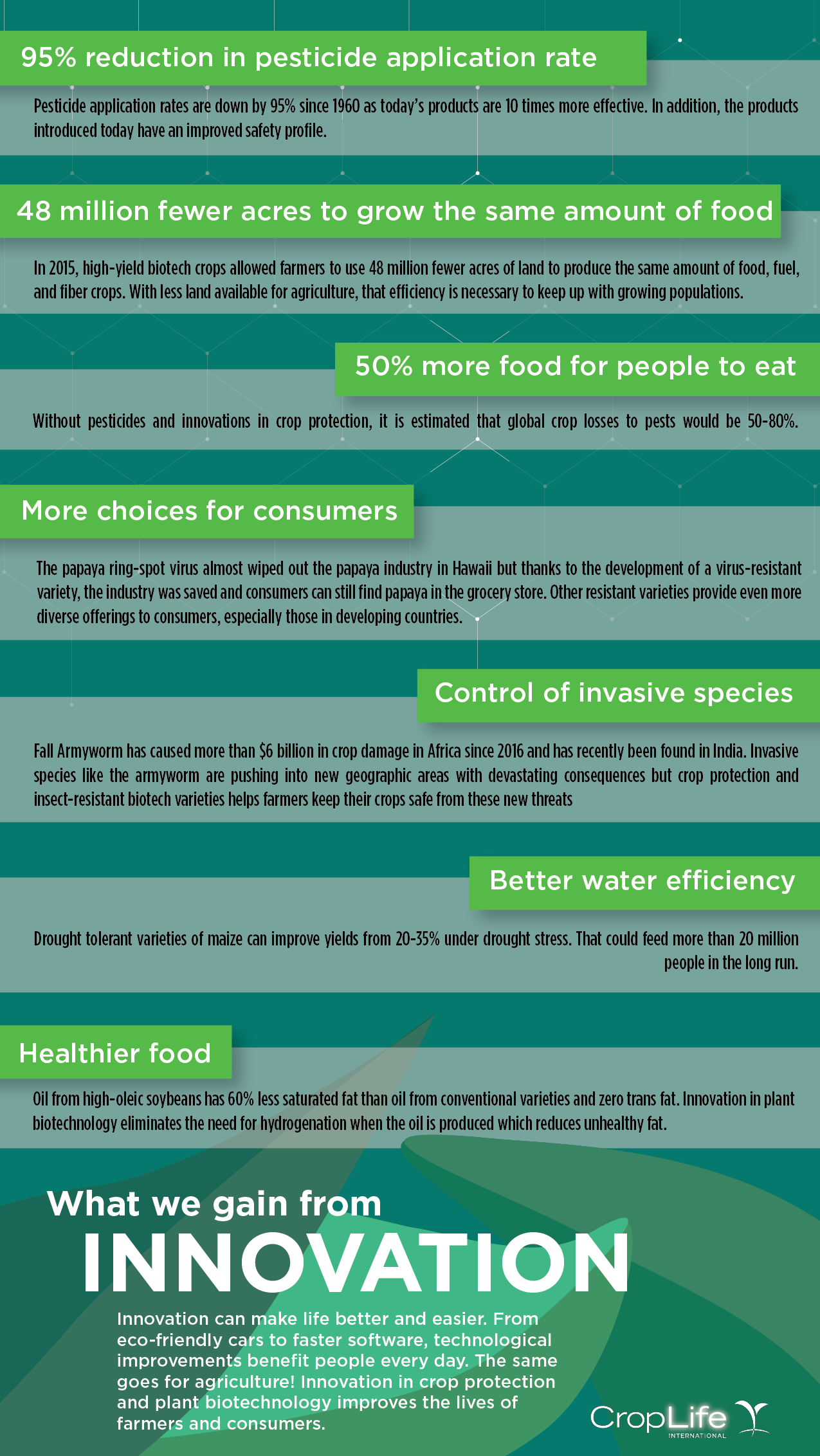Plant Innovation and Biotechnology is Key to the Future

In virtually every technology and industry, innovation is seen as a positive. Eco-friendly cars, personalized medicine, virtual reality, and smart appliances are seen as not only the wave of the future but as necessary to meet the demand of consumers. But somehow, innovation in food and agriculture is seen as a negative by many. We’re here to point out that innovation in food and farming is not only a positive but could be the only solution to feed a growing global population by 2050. Here are some of our top resources on innovations in GMOs, plant biotechnology, plant science, and modern agriculture that will get you excited for the future of food and farms!
Innovation And Choice: Leading Today's GMO Conversations
In 1996, the first genetically modified (GM) crop was introduced for commercial production. In the time since, ten GM crops have entered the U.S. commercial market and more than 4.4 billion acres of GM crops have fed hungry populations across the world, bolstered economies and helped reduce the environmental impact of farming.
To commemorate 20 years of biotech innovation, we invited a diverse group of experts in academia, agriculture, science and media to discuss “The Future of GMOs & Their Role in Sustainability.” During the discussion, experts explored the impact of biotechnology and what’s next in the future. Find out what we talked about in the article from Forbes.
20 Years Of Innovation: Reflecting On Successes And Challenges Of Biotech Crops
In 1996, farmers planted the first commercial biotech crop. The global uptake of plant biotechnology by farmers since has made it the fastest-adopted technology in the history of agriculture. Farmers who have the choice to use the technology have chosen it on an unprecedented level because of its benefits.
However, today those farmers are no longer being provided the choice to utilize a broader suite of technologies on more crops in more places from a diverse set of technology providers. The regulatory hurdle is too high and completely disproportional to any risk presented by plant biotechnology. This needs to change if the world’s innovation is to be used by our farming communities for society’s greater good. Read more about choice, innovation, and technology at Forbes.
Paper: Plant Breeding and Genetics
Plant Breeding and Genetics is a paper in the series on The Need for Agricultural Innovation to Sustainably Feed the World by 2050. Humans depend on plants for food, feed, fiber, and fuel—as well as less tangible aspects of life such as aesthetics and environmental stability. This paper is the first in a series that connects science and technology to agriculture, and it focuses on the critical importance of innovation in plant breeding to meet the challenge of providing food and nutritional security to humankind. Learn more about innovations in plant breeding and genetics in this paper from CAST.
Farmers of the future will utilize drones, robots and GPS

Today’s agriculture has transformed into a high-tech enterprise that most 20th-century farmers might barely recognize. After all, it was only around 100 years ago that farming in the US transitioned from animal power to combustion engines.
Over the past 20 years the global positioning system (GPS), electronic sensors and other new tools have moved farming even further into a technological wonderland. Beyond the now de rigeur air conditioning and stereo system, a modern large tractor’s enclosed cabin includes computer displays indicating machine performance, field position and operating characteristics of attached machinery like seed planters.
And as amazing as today’s technologies are, they’re just the beginning. Self-driving machinery and flying robots able to automatically survey and treat crops will become commonplace on farms that practice what's come to be called precision agriculture. Learn more about high tech modern agriculture at The Conversation.
Op-Ed: Plant Breeding Innovation Can Help Solve Global Challenges
Plant breeding innovations must play a role to address global challenges such as climate change, a growing population, and the need for resource-efficient farming systems, according to a 2019 Transgenic Research article by Petra Jorasch of the International Seed Federation.
Improved plant varieties that can withstand pests and diseases using fewer resources, plants exhibiting stable yield amidst unstable climate, and plants with improved productivity through efficient use of water, land, and nutrients, can help contribute to achieving the goal of meeting the global challenges. Jorasch emphasized the long history of innovation in plant breeding. From selection breeding to precision breeding, the main goals of the breeding methods are mainly focused on increasing genetic diversity and choosing the best performing plants. Learn more about the importance of plant breeding innovation in this brief from ISAAA.
Infographic: What We Gain From Innovation
Ever wonder what innovation looks like in agriculture? Check out a few of plant science’s most notable benefits and see how they are helping farmers and consumers.
Video: Why Does Innovation Matter?
There is a need for agricultural technology that improves sustainability in Europe. A scientist, a policymaker, and three farmers talk about the need for equipping growers with the proper tools, supporting a pro-innovation regulatory system, and continually finding better and more effective ways of growing the food we eat. Watch the video at the CropLife International website.
High Oleic Soybean Oil: A U.S. Soy Innovation
Since before Henry Ford used soy as a plastic component in the Ford Model T car, technological innovation has been at the backbone of the U.S. Soy Advantage. From enhanced seed varieties to precision farming technology, the U.S. Soy industry has a long history of innovation.
High oleic soybean varieties are one of the most recent achievements in U.S. soybean innovation. When it comes to high oleic soybeans, their performance advantages don’t stop at the farm. Learn more about the heart-healthy high oleic soybeans at U.S. Soy.
How GMO Technology Saved the Papaya
Oh, sweet summertime. These long, hot days are the perfect chance to enjoy cool, refreshing fruits and vegetables. They keep you hydrated, are chock full of vitamins and are, of course, delicious. Pineapple. Watermelon. Strawberries. I could go on.
But one popular summertime fruit, the papaya, was almost wiped out. June is National Papaya Month and a great time not just to enjoy papayas, but also to learn about how it’s only thanks to biotechnology that we’re all able to eat Hawaiian papaya today.
Without biotechnology, “There’s no papaya industry. Simple as that,” said Dennis Gonsalves, the scientist who developed the GMO papaya. Learn about the technological innovation that saved the Hawaiian rainbow papaya from the International Food Information Center.
From the lab to the field: Center for Plant Science Innovation is transforming agriculture
While basic plant science research is at the core of the Center for Plant Science Innovation (PSI) at the University of Nebraska–Lincoln, what the Center actually does is anything but basic. PSI faculty are making groundbreaking discoveries in the areas of metabolic biochemistry, stress biology, and genetics and epigenetics. While the research is groundbreaking, PSI Director Edgar Cahoon believes the ability to bring these findings to the field is what makes the center unique.

"The Center for Plant Science Innovation has a strong foundation in basic research and we really value that, but we also realize that this basic research has to be translated into new products and new technologies to have real impact," said Cahoon. Outcomes from PSI research have led to improved stress tolerance, more nutritious crops, improved bioenergy qualities, and enhanced yields. Learn more about the center from the University of Nebraska-Lincoln.
